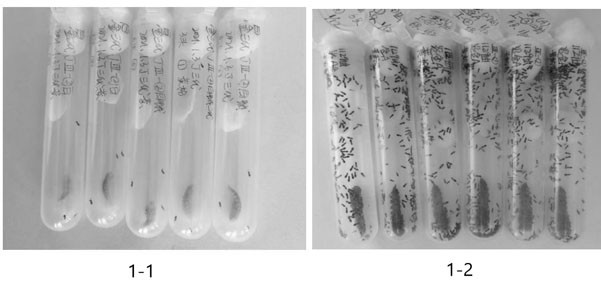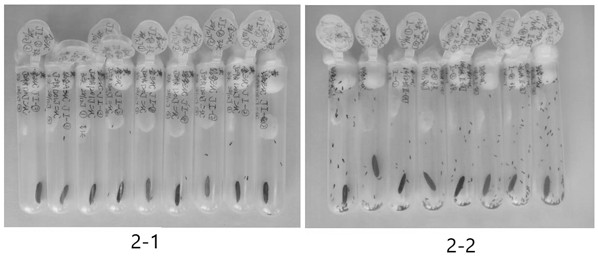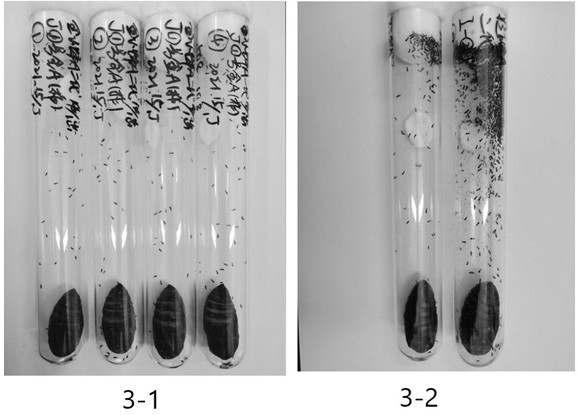A kind of method of golden wasp controlling American white moth
A technology of American white moth and golden bee, applied in invasive species monitoring, climate sustainability, animal husbandry, etc., can solve the problems of low success rate of replacement hosts and unstable bee numbers, and improve labor productivity. and equipment use efficiency, reducing artificial reproduction costs, and the effects of low reproduction costs
- Summary
- Abstract
- Description
- Claims
- Application Information
AI Technical Summary
Problems solved by technology
Method used
Image
Examples
Embodiment 1
[0029] Embodiment 1 The influence of the breeding methods of different yellow-pink beetle pupae on the effect of docking bees
[0030] Cultivation method of yellow-pink beetle pupae Ⅰ: The method of breeding Helicoverpa armigera golden wasp by gradient cooling, yellow-pink beetle is from the subcultured population in the laboratory. Placed at a temperature of 22-28° C., a relative humidity of 50-70%, and a photoperiod of L:D=16h:8h; subcultured in a rearing box with feeds such as wheat bran, vegetables and fruits. In the pupation stage, the above-mentioned yellow powder armor pupae are transferred from 22-28 ℃ into the insect raising box with ventilation holes and then carry out the gradient cooling treatment; the gradient cooling treatment is: placed in a 16 ℃ incubator and placed for 2 hours , and then placed in a 10°C incubator for 2 hours to obtain yellow-pink bee pupae for receiving bees, which were stored in a 4°C incubator in the dark for 1-20 days, so that all pupae we...
Embodiment 2
[0038] Example 2 Comparison of the effects of different alternative hosts for breeding Helicoverpa armigera
[0039] 1. Host Screening Assay
[0040](1) The pupae of American white moth, which were collected in the field and parasitized by Helicoverpa armigera, were placed under the conditions of temperature of 22-28°C, photoperiod L:D=16h:8h, and relative humidity of 50-70%. , the feed is honey water with a concentration of 5%, and cultivated until the bees emerge;
[0041] (2) put into the bottom of the 10ml centrifuge tube with the yellow powder beetle pupae (see the breeding method Ⅰ of the yellow powder beetle pupae of embodiment 1) for the breeding method; the Helicoverpa armigera female bee is connected to the centrifuge tube, the golden wasp female bee and the substitute host The quantity ratio is 3:1, place a piece of absorbent cotton ball soaked in 5% honey water at the upper inner wall of the centrifuge tube, pick up the bees after 48 hours, remove the adult bees i...
Embodiment 3
[0047] The influence of embodiment 3 passage breeding on the cotton bollworm golden wasp
[0048] According to the breeding method of Tenebrio molitor pupa through gradient cooling method (treatment 1), control 1, control 2, and control 3, 4 generations were continuously bred respectively, and the above-mentioned 1st generation and 3rd generation of the golden wasp were counted. The eclosion rate and male-to-male ratio.
[0049] Table 3 compares the effect of raising this golden bee by passage
[0050]
[0051] The data in Table 3 show that after 6 consecutive generations of breeding of Tenebrio molitor pupa by gradient cooling, the species emergence rate of Helicoverpa spp. was improved, but the sex ratio did not change significantly.
PUM
 Login to View More
Login to View More Abstract
Description
Claims
Application Information
 Login to View More
Login to View More - R&D
- Intellectual Property
- Life Sciences
- Materials
- Tech Scout
- Unparalleled Data Quality
- Higher Quality Content
- 60% Fewer Hallucinations
Browse by: Latest US Patents, China's latest patents, Technical Efficacy Thesaurus, Application Domain, Technology Topic, Popular Technical Reports.
© 2025 PatSnap. All rights reserved.Legal|Privacy policy|Modern Slavery Act Transparency Statement|Sitemap|About US| Contact US: help@patsnap.com



